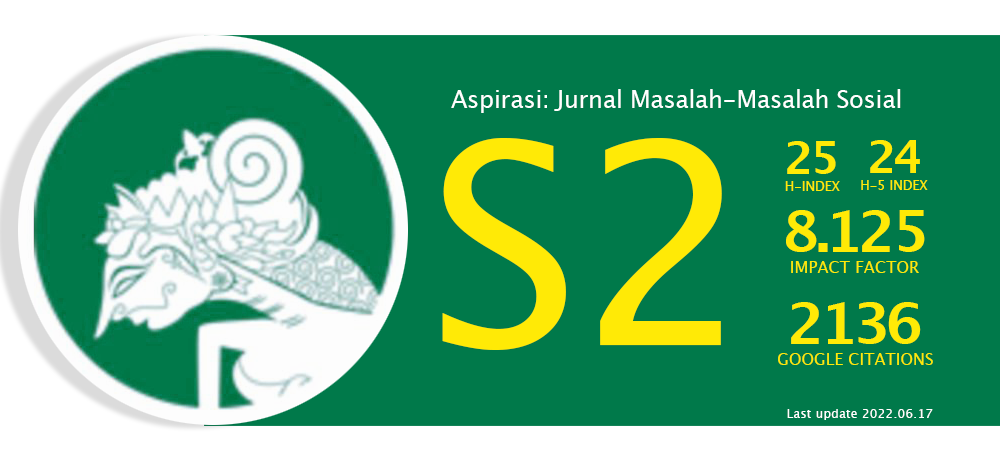Education and Women’s Job Transition During the Pandemic Covid-19
Abstract
Pandemi Covid-19 berdampak pada penurunan ekonomi yang mengakibatkan penurunan jam kerja bahkan kehilangan pekerjaan. Akan tetapi, terdapat peningkatan partisipasi angkatan kerja perempuan yang disertai dengan penyerapan tenaga kerja di sektor informal. Banyak perempuan mulai bekerja untuk menambah penghasilan keluarga. Sektor informal menjadi pilihan perempuan karena kemudahan dan tidak memerlukan keahlian khusus. Pendidikan sebagai modal yang dimiliki pekerja mempunyai pengaruh terhadap pilihan memasuki pekerjaan sehingga menentukan transisi pekerjaan yang akan dipilih pekerja dalam menghadapi dampak pandemi. Oleh karena itu, penelitian ini bertujuan untuk mengetahui pengaruh pendidikan terhadap reaksi ekonomi perempuan dalam mengatasi pandemi Covid-19 dengan melihat transisi pekerjaan perempuan dan apakah pengaruh tersebut sama pada perempuan muda dan dewasa. Dengan menggunakan data Survei Angkatan Kerja Nasional 2020 dan metode analisis regresi logistik multinomial terhadap 26.087 sampel yang terdiri dari 8.407 perempuan usia muda dan 17.680 perempuan dewasa serta 6.902 perempuan yang melakukan inmover formal, 16.472 perempuan inmover informal, dan 2713 perempuan outmover, ditemukan bahwa perempuan dengan pendidikan tinggi memiliki peluang lebih besar untuk melakukan inmover ke sektor formal dan lebih kecil kemungkinannya untuk melakukan inmover ke sektor informal dibandingkan menjadi pengangguran. Peluang untuk melakukan transisi ke sektor formal lebih tinggi di kalangan perempuan muda. Pada perempuan dewasa, peluang tersebut lebih rendah karena tanggung jawab dalam pengasuhan anak dan pekerjaan rumah tangga. Selain pendidikan, perempuan kawin dan menjadi kepala rumah tangga lebih berpeluang untuk melakukan transisi ke sektor informal karena kemudahan memasuki pekerjaan dengan kendala yang mereka miliki dalam rangka meningkatkan pendapatan di masa pandemi Covid-19.
Abstract: The Covid-19 pandemic has impacted the economic downturn, which has resulted in decreased working hours and even lost jobs. However, there has been an increase in women’s labor force participation accompanied by employment in the informal sector. Many women start working to supplement their family income. The informal sector is the choice of women because of its convenience and does not require special skills. Education as capital owned by workers influences the choice of entering a job, determining the job transition workers will choose in dealing with the impact of the pandemic. Therefore, this study aims to assess the effect of education on women’s economic reactions in overcoming the Covid-19 pandemic by looking at women’s work transitions and whether this effect is the same for young and adult women. Using data from the 2020 National Labor Force Survey and the multinomial logistic regression analysis method for 26,087 samples consisting of 8,407 young women and 17,680 adult women as well as 6,902 women who were formal inmover, 16,472 women who were informal inmovers, and 2713 women who were outmovers, it was found that women with higher education tend to enter formal jobs and are less likely to enter informal jobs than become unemployed. The increased propensity to enter formal employment is higher among young women. In adult women, the tendency to work is lower because of childcare and household responsibilities. Apart from education, women who are married and heads of households are more likely to enter the informal sector due to the ease of entering work with the constraints they have to increase their income during the Covid-19 pandemic
Keywords
Full Text:
PDFReferences
Adams-Prassl, A., Boneva, T., Golin, M., & Rauh, C. (2020). Inequality in the impact of the coronavirus shock: Evidence from real time surveys. Journal of Public Economics, 189, 104245. https://doi.org/10.1016/j.jpubeco.2020.104245
Albertini, J., Poirier, A., & Sopraseuth, T. (2020). Informal work along the business cycle: Evidence from Argentina. IZA Journal of Development and Migration, 11(1), 1–16. https://doi.org/10.2478/izajodm-2020-0019
Alon, T., Doepke, M., Olmstead-Rumsey, J., & Tertilt, M. (2020). The impact of COVID-19 on gender equality. In CRC TR 224 Discussion Paper Series University of Bonn and University of Mannheim. Germany. https://ideas.repec.org/p/bon/boncrc/crctr224_2020_163.html
Anderson, P. M., Meyer, B. D., Pencavel, J., & Roberts, M. J. (1994). The extent and consequences of job turnover. Brookings Papers on Economic Activity. Microeconomics, 1994, 177–248. https://doi.org/10.2307/2534731
Augustus, J. (2021). The impact of the Covid-19 pandemic on women working in higher education. Frontiers in Education, 6, 648365. https://doi.org/10.3389/feduc.2021.648365
Badan Pusat Statistik. (2006). Statistik ketenagakerjaan usia muda di Indonesia. Badan Pusat Statistik.
Badan Pusat Statistik. (2020). Survei angkatan kerja nasional Agustus 2020. Badan Pusat Statistik. https://www.bps.go.id/publication/2020/12/23/d8b9a75ce826ddafbddb9657/booklet-survei-angkatan-kerja-nasional-agustus-2020.html
Balde, R., Boly, M., & Avenyo, E. (2020). Labour market effects of COVID‐19 in Sub‐Saharan Africa: An informality lens from Burkina Faso, Mali and Senegal [MERIT Working Papers 2020-2022]. United Nations University - Maastricht Economic and Social Research Institute on Innovation and Technology (MERIT).
Bartel, A. P., & Borjas, G. J. (1978, October). Wage growth and job turnover: An empirical analysis [NBER Working Paper No. w0285]. https://papers.ssrn.com/sol3/papers.cfm?abstract_id=260475
Becker, G. S. (1994). Human capital: A theoretical and empirical analysis with special reference to education (3rd ed.). University of Chicago Press. https://www.nber.org/books-and-chapters/human-capital-theoretical-and-empirical-analysis-special-reference-education-third-edition
Bonacini, L., Gallo, G., & Scicchitano, S. (2021). Will it be a secession? The unintended influence of working from home on the gender wage gap related to the COVID-19 pandemic [GLO Discussion Paper No. 771]. In the GLO Discussion Paper Series, Global Labor Organization (GLO). Global Labor Organization (GLO). http://hdl.handle.net/10419/229149
Borjas, G. J. (2016). Labor economics (7th ed.). McGraw-Hill.
Brodeur, A., Gray, D., Islam, A., & Bhuiyan, S. J. (2021). A literature review of the economics of covid19. Journal of Economic Surveys, 35(4), 1007-1044. https://docs.iza.org/dp13411.pdf
Costoya, V., Echeverría, L., & Thailinger, A. (2020). The impact of COVID-19 in the allocation of time within couples (Issue Evidence for Argentina) [Working Papers 145]. Universidad de San Andrés, Departamento de Economía, revised Aug 2020.
Dalilah, F. (2020). Analisis terhadap partisipasi kerja perempuan pada sektor formal di Indonesia. Jurnal Ilmiah Mahasiswa FEB Universitas Brawijaya, 9(2).
Dartanto, T., Moeis, F. R., & Otsubo, S. (2019). Intergenerational economic mobility in Indonesia : a transition from poverty to middle class in 1993–2014. Bulletin of Indonesian Economic Studies. https://doi.org/10.1080/00074918.2019.1657795
Gebeyaw, T. (2011). Socio-demographic determinants of urban unemployment: the case of Addis Ababa. Ethiopian Journal of Development Research, 33(1), 79-124. https://doi.org/10.4314/ejdr.v33i1.68615
Glick, P., & Sahn, D. E. (1997). Gender and education impacts on employment and earnings in West Africa: evidence from Guinea. University of Chicago Press. https://doi.org/10.1086/452308
Gutierrez, I. A., Kumar, K. B., Mahmud, M., Munshi, F., & Nataraj, S. (2021). Transitions between informal and formal employment: results from a worker survey in Bangladesh. ZA Journal of development and Migration, 9(3), 1-27. https://doi.org/10.1186/s40176-019-0141-2
Ham, A., Maldonado, D., & Guzmán-Gutiérrez, C. S. (2021). Recent trends in the youth labor market in Colombia: Diagnosis and policy challenges. IZA Journal of Labor Policy, 11(1), 1-32. https://doi.org/10.2478/izajolp-2021-0007
Hosmer, D. W., & Lemeshow, S. (2000). Applied logistic regression (Second ed.). John Wiley & Sons.
ILO. (2004). ILO: Laporan mengenai tenaga kerja muda di Indonesia. Lembaga Penyelidikan Ekonomi dan Masyarakat, Fakultas Ekonomi, Universitas Indonesia dan ILO.
ILO. (2018, March 8). Women still less likely to be active in the labour market than men in most of the world. ILO. https://www.ilo.org/global/about-the-ilo/newsroom/news/WCMS_619119/lang--en/index.htm
ILO. (2021, January 25). Ketidakpastian dan ketimpangan pemulihan diprediksi terjadi seiring krisis pasar tenaga kerja. ILO. https://www.ilo.org/jakarta/info/public/pr/WCMS_767366/lang--en/index.htm
Indayani, S., & Pitoyo, A. J. (2020). Analisis pengangguran dan pertumbuhan ekonomi sebagai akibat pandemi covid-19. Perspektif: Jurnal Ekonomi & Manajemen Universitas Bina Sarana Informatika, 18(2), 201-208.
Isti'any, N. N., & Pitoyo, A. J. (2016). Pekerja perempuan dalam sektor informal di Daerah Istimewa Yogyakarta analisis faktor pengaruh berdasarkan susenas kor 2014. Jurnal Bumi Indonesia, 5(4).
Kikuchi, S., Kotao, S., & Mokoshiba, M. (2021). Who suffers from the COVID-19 shocks? Labor market heterogeneity and welfare consequences in Japan. Journal of the Japanese and International Economies, 59(1011117). https://doi.org/10.1016/j.jjie.2020.101117
Kletzer, L. G. (1998). Who gets displaced: The characteristics of permanent job loss. Journal of Economic Perspectives, 12(1), 115-136.
KPPPA & BPS. (2018). Profil generasi milenial Indonesia. KPPPA & BPS.
Kristal, T., & Yaish, M. (2020). Does the coronavirus pandemic level the gender inequality curve? (It doesn’t). Research in Social Stratification and Mobility, 68(100520). https://doi.org/10.1016/j.rssm.2020.100520
Lee, K. D., Lee, S. H., & Choe, J. I. (2017). State dependence, individual heterogeneity, and the choice of employment status: evidence from Korea. Applied Economics, 50(8), 824-837. https://doi.org/10.1080/00036846.2017.1343447
Lemieux, T., Milligan, K., Schirle, T., & Skuterud, M. (2020). Initial impacts of the covid-19 pandemic on the Canadian labour market. Canadian Public Policy, 46(S1), S55-S65. https://doi.org/10.3138/cpp.2020-049
López-Bazo, E., & Motellón, E. (2013). The regional distribution of unemployment: What does micro-data tell us? Papers in Regional Science, 92(2), 383-405. https://doi.org/10.1111/j.1435-5957.2012.00456.x
Maciel, F. T., & Oliveira, A. M. H. C. (2018). Dynamics of the formal and informal labour in Brazil: occupational and earnings mobility. International Journal of Development Issues, 17(1), 28-54. https://doi.org/10.1108/IJDI-07-2017-0129
Mincer, J. (1991). Education and unemployment. NBER Working Paper, 3838, 1-23.
Mwangangi, F. W. (2014). Factor affecting employees turnover in the pharmaceutical industry: A case of Phillips Group of Companies Kenya. University of Africa. https://core.ac.uk/download/pdf/45380883.pdf
Ngadi, Meliana, R., & Purba, Y. A. (2020). Dampak pandemi covid-19 terhadap PHK dan pendapatan pekerja di Indonesia. Jurnal Kependudukan Indonesia, (Edisi Khusus Demografi dan COVID - 19), 43–48. https://doi.org/10.14203/jki.v0i0.576
Porta, R. L., & Shleifer, A. (2014). Informality and development. Journal of Economic Perspectives, 28(3), 109-126. https://doi.org/10.1257/jep.28.3.109
Prates, I., & Barbosa, R. J. (2020). The impact of COVID-19 in Brazil : Labour market and social. The Indian Journal of Labour Economics, 63(Suppl 1), 31–35. https://doi.org/10.1007/s41027-020-00252-3
Qayyum, W. (2007). Causes of youth unemployment in Pakistan. The Pakistan Development Review, 46(4), 611–621. https://doi.org/10.30541/v46i4IIpp.611-621
Rivera, V., & Castro, F. (2021). Between social protests and a global pandemic: Working transitions under the economic effects of Covid-19. Social Sciences, 10(4), 145. https://doi.org/10.3390/socsci10040145
Schaner, S., & Das, S. (2016). Female labor force participation in Asia: Indonesia country study. In Asian Development Bank Economics Working Paper Series No. 474. https://papers.ssrn.com/sol3/papers.cfm?abstract_id=2737842
Shita, A., & Dereje, M. (2018). Determinants of urban youth unemployment: Evidence from East Gojjam Zone, Ethiophia. International Journal of Economic Development, 11(2), 245–265.
Tansel, A., & Acar, E. Ö. (2017). Labor mobility across the formal/informal divide in Turkey: Evidence from individual-level data. Journal of Economic Studies, 44(4), 617–635. https://doi.org/10.1108/JES-06-2015-0103
Taufiq, N., & Dartanto, T. (2020). Education, informal turnover and poverty dynamics in Indonesia. International Journal Of Economics and Management, 14(1), 157–172. http://www.ijem.upm.edu.my/vol14no1/11)%20Education,%20Informal%20Turnover.pdf
Thiede, B. C., & Monnat, S. M. (2016). The great recession and America's geography of unemployment. Demographic Research, 35(1), 891–928. https://doi.org/10.4054/DemRes.2016.35.30
Thomas, D., Beagle, K., & Frankenberg, E. (2020). Labor market transitions of men and women during an economic crisis: Evidence from Indonesia [Working Paper Series 00-11]. In the Labor and Population Program. rand.org. https://www.rand.org/content/dam/rand/pubs/drafts/2008/DRU2344.pdf
Wandaweka, A. T., & Purwanti, D. (2021). Determinan partisipasi kerja perempuan dalam sektor informal di Indonesia tahun 2019. Seminar Nasional Official Statistics, 2021(1), 652–661. https://doi.org/10.34123/semnasoffstat.v2021i1.994
Yuniati, M., & Mataram, N. W. (2019). Profil tenaga kerja perempuan berdasarkan umur, tingkat pendidikan, sektor formal, informal di Provinsi NTB Tahun 2016–2018 beserta analisis ekonominya. Media Bina Ilmiah, 13(12), 1855–1862.
DOI: https://doi.org/10.46807/aspirasi.v14i2.3334
Refbacks
- There are currently no refbacks.








